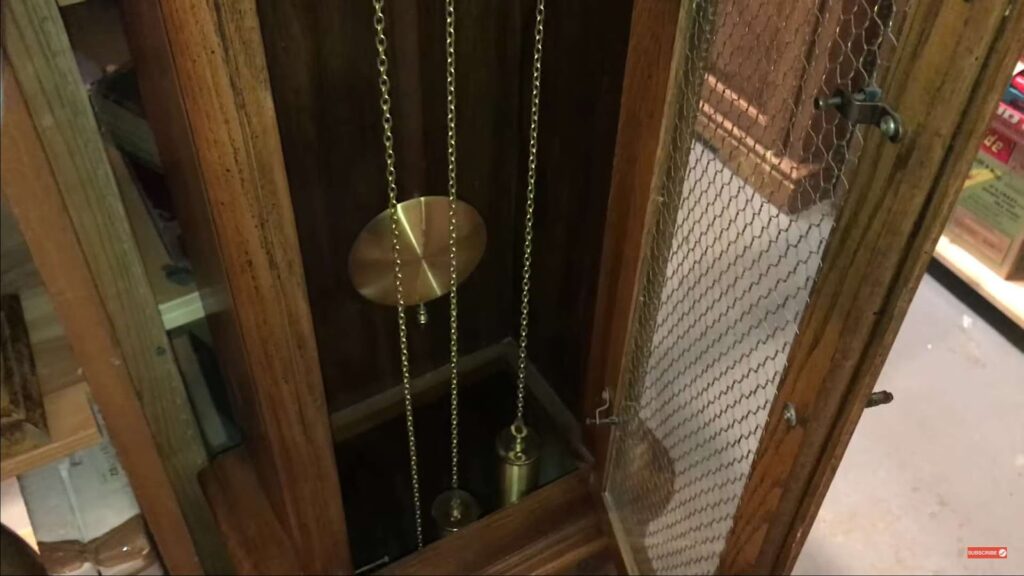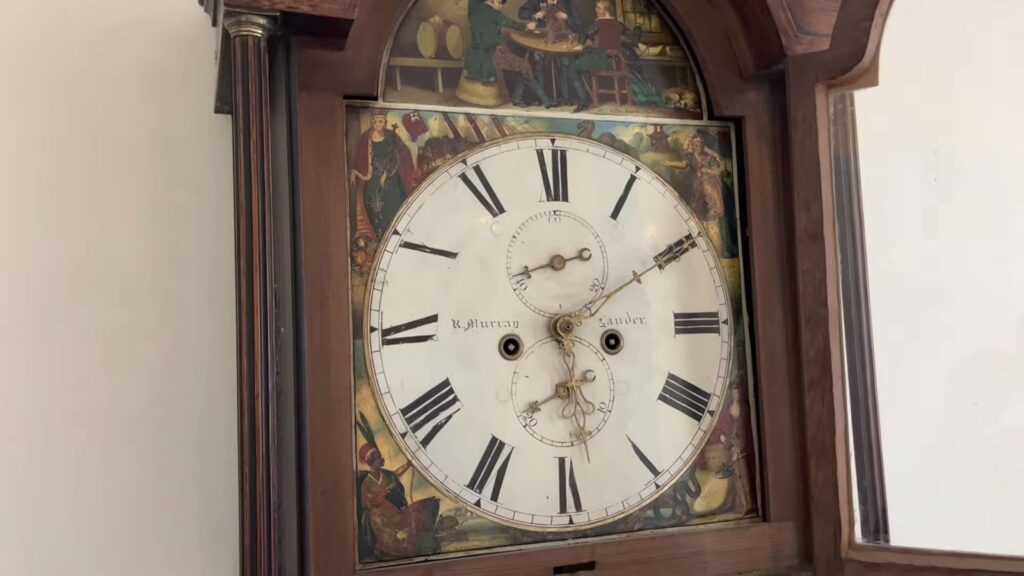The passage of time possesses a remarkable ability to stir feelings of nostalgia and admiration. Few timekeeping instruments capture this sentiment as profoundly as the venerable grandfather clock. These stately and majestic chronometers, bearing witness to the passage of centuries, have graced the interiors of homes, imparting both visual splendor and precise functionality.
Within the confines of this article, we shall embark on a captivating journey into the essence of these iconic horological treasures. We will delve into the intricate and captivating elements that compose the intricate tapestry of a grandfather clock. From the grand visage that dutifully records the progression of hours and minutes to the enchanting chimes that reverberate through time’s vast expanse, accompany us as we unveil the inner mechanisms and rich historical tapestry that coalesce to form the harmonious elegance embodied by a grandfather clock.
Exploring the Grandeur of Grandfather Clock Cases
The Upper Segment of the Grandfather Clock: A Sanctuary of Refinement
At the zenith of the grandfather clock case resides the upper part, a realm characterized by refinement and masterful craftsmanship. This uppermost section primarily accommodates the clock’s intricate mechanisms and is commonly referred to as the “Hood” or “Bonnet.” Within this elevated region, you’ll encounter two noteworthy components:
- The Grandfather Clock Crown: This regal feature adorns the clock with an aura of sophistication and charisma. Grandfather clock crowns manifest in a plethora of styles, each exuding its own distinctive character. Here, we highlight four notable types;
- Swan’s Neck Crown: A swan’s neck crown is a timeless choice, characterized by its graceful, curved design. At its center stands a finial, sometimes resembling an eagle, crafted from wood or cast brass. Some models even embellish this crown with additional wooden accents, like two finials or spires on the sides, adding a touch of opulence to the clock;
- Bonnet Crown: Often referred to simply as the “hood,” the bonnet crown forms a full arched facade. It provides a canvas for exquisite overlays and intricate wooden carvings, elevating the clock’s aesthetic to a level of grandeur;
- Flat Top Crown: For those who appreciate simplicity and minimalism, the flat top crown is a perfect choice. It embraces clean lines and understated details, allowing the clock’s inherent charm to shine through without overwhelming ornamentation;
- Federal Crown: The federal crown exudes a sense of stateliness with its pinnacle facade. It adds a touch of grandeur to the clock’s appearance, making it a focal point in any room.
Exploring the Grandeur of the Grandfather Clock Face
Within the core of each grandiose grandfather clock resides its venerable countenance, recognized as the dial. This entrancing focal point not only possesses the means to chronicle time’s passage but also functions as a platform for the manifestation of elaborate artistry and design. Let us embark on a journey into the opulent intricacies of the grandfather clock’s countenance, revealing the craftsmanship and utility it encompasses.
Traditionally, the dial of the grandfather clock includes:
- Hour and Minute Hands: The hour hand, often an epitome of elegance, can range from minimalistic to exquisitely detailed designs. Minute hands made their appearance once clocks achieved remarkable accuracy due to the invention of the total escapement mechanism;
- Cast Corners or Spandrels: These are ornate frame elements that adorn the corners of fine grandfather clocks, adding a touch of opulence to the dial’s aesthetics;
- Center Disk: The central disk, meticulously embellished, further enhances the dial’s visual appeal, showcasing the meticulous craftsmanship of clockmakers;
- Chapter Ring: Positioned around the dial, the chapter ring displays numerals, which can be either in Arabic or Roman numerals, imparting a classic touch to the clock’s face;
- Winding Holes: On cable-driven key-wound mechanisms, you’ll find winding holes, allowing you to maintain the clock’s precision by regularly winding it;
- Chimes Levers: These levers provide the means to adjust the melodious chimes of the grandfather clock, allowing you to customize the auditory experience.
Additionally, the grandfather clock face boasts these notable features:
- Moon Dial: Adding a celestial touch, the moon dial tracks the 29.5-day lunar cycle, mirroring the moon’s phases and position in the night sky. As the image of the moon moves, it elegantly reveals the lunar date, captivating both stargazers and horologists alike;
- Elegant Glass Door with a Secure Lock: Designed to shield the clock’s dial and intricate inner workings, the upper door is meticulously crafted from transparent glass and frequently comes with a secure locking mechanism. This ensures the safeguarding of the clock’s delicate components, all the while permitting effortless observation;
- Lateral Glass or Wooden Access Panels: These specialized panels, occasionally adorned with beveled glass to offer a tantalizing peek into the clock’s inner machinery, serve as convenient gateways to access the clock’s intricate mechanisms, which orchestrate the graceful dance of time.
Unveiling the Grandeur of the Grandfather Clock’s Middle Part
The Pendulum: The Heartbeat of the Grandfather Clock
A masterpiece of timepiece craftsmanship, the pendulum remains an integral part of the grandfather clock’s legacy, seamlessly blending art with precision engineering. Its role in timekeeping is paramount, influencing the very ethos of tall-case clock designs. Here’s an insightful exploration into the components that make the pendulum an emblem of horological excellence:
Pendulum Stick or Pendulum Lyre:
- Role: Acting as the rhythmic pulse of the clock, the pendulum stick or lyre, hanging from a sturdy support, orchestrates the cadence of the clock, ensuring its ticks align with the passage of time;
- Significance: This component’s undulating motion serves as a visual representation of the clock’s heartbeat, merging beauty with purpose.
Pendulum Bob:
- Role: Positioned strategically at the pendulum’s extremity, the bob functions as a counterweight, anchoring the pendulum’s consistent and rhythmic motion;
- Insight: The steady oscillation of the pendulum bob is fundamental to the clock’s accurate timekeeping.
Cast Center:
- Role: More than just a functional component, the cast center embedded in the pendulum bob elevates the aesthetic grandeur of the grandfather clock;
- Highlight: By seamlessly blending elegance with utility, the cast center serves as a testament to the artistry and craftsmanship that goes into each grandfather clock.
Time Adjustment Screw:
- Role: Nestled at the base of the pendulum bob, this screw offers a hands-on approach to calibrate the clock’s timing.
Tips for Precision:
- If the clock seems to lag, a slight adjustment can hasten its pace;
- Conversely, if it’s racing ahead, tweaking the screw can temper its speed;
- Endnote: Through these subtle calibrations, a grandfather clock can be bequeathed across generations, ensuring its timekeeping remains impeccable.
Grandfather Clock Weights: The Heartbeat of Timekeeping
Grandfather clocks are renowned for their intricate mechanical systems. At the core of these mechanisms lie the weights, which perform distinct functions. A typical mechanical grandfather clock houses three vital weights:

- The Right Weight: This is not merely a mass but the maestro of melodies. It governs the melodious chime sounds that resonate from the clock, marking the passage of time with its rhythmic beats;
- The Central Weight: It is the life force of the clock, fueling the movement of the pendulum. The pendulum’s steady swing ensures that the clock ticks accurately, making this weight indispensable;
- The Left Weight: While the right weight handles melodies, the left weight ensures that every hour is announced distinctly. It is in charge of the hour strike, making the listener aware of the hour’s arrival.
When examining these weights more closely, a few components stand out:
- Weight Shell: Whether banded or etched, the exterior casing of the weight often boasts intricate designs, giving the clock its antique charm;
- End Caps: Serving as the protective shields, these are positioned at both the top and bottom of the weight shell;
- Cable Pulleys: For those grandfather clocks using a cable-driven movement, these pulleys are crucial, ensuring smooth motion as they bear the weight;
- Weight Hooks and Rings: Specifically designed for chain-driven movements, these components are tasked with supporting the weights, ensuring they hang correctly.
The Base Section of the Grandfather Clock: The Foundation of Elegance
Often referred to simply as the ‘Base Section’, the bottom of a grandfather clock is a testament to craftsmanship. It’s not just about support; it’s about artistry and design.
Delving into the base section’s components:
- Base Panel: This forms the very facade of the clock’s base, often adorned with intricate designs or patterns, showcasing the craftsmanship behind these timeless pieces;
- Base Molding: Beauty often lies in the details. The base molding is a decorative enhancement, adding depth and elegance to the clock. While primarily crafted from the clock’s main wood, artisans sometimes use contrasting woods to add a touch of uniqueness;
- Clock Foot: More than just a support system, the clock foot is often intricately designed, adding to the overall aesthetics of the grandfather clock;
- Levelers: Ensuring stability is paramount, especially for a piece as delicate as a grandfather clock. Beneath each clock foot, levelers are strategically placed. These provide the clock with a firm footing, even on undulating surfaces or plush carpets, ensuring the clock stands tall and true through the ages.
Conclusion
In summary, the exquisite and enduring artistry exhibited by a grandfather clock stands as a tribute to its historical importance and lasting charm. Our exploration has delved into the diverse elements that collaborate in the construction of this remarkable chronometric masterpiece. From the graceful wooden enclosure enveloping the delicate pendulum and weights, to the impeccably fashioned clock visage and the intricate machinery governing its motion, each constituent plays a pivotal role in both the practical functionality and the aesthetic allure of the grandfather clock.
These ageless timekeeping devices not only function as precise chronometers but also as treasured heirlooms, perpetually handed down through successive generations, bearing the narratives and reminiscences of their previous custodians. The artistry and precision requisite for the creation and preservation of a grandfather clock bear testimony to the unwavering commitment of horologists and artisans who steadfastly carry forth this age-old tradition.
